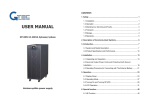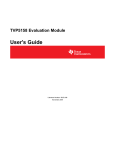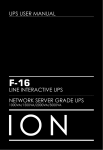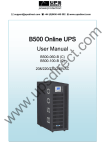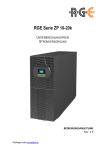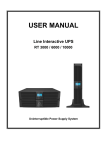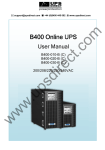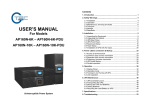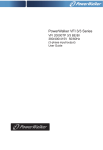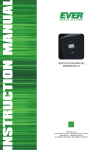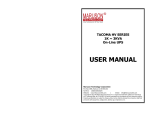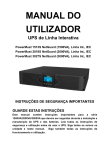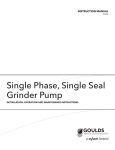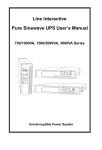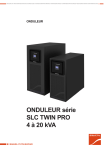Download 1. Safety - UPS Direct
Transcript
.c om B500 Online UPS User Manual B500EVO-100-B B500EVO-200-B w w w .u ps d ire ct 200/208/220/230/240VAC CONTENT: 1. SAFETY .................................................................................................... 1 .c om 1.1 Installation...................................................................................... 1 1.2 Operation ....................................................................................... 2 1.3 Maintenance, servicing and faults ................................................. 2 1.4 Transport........................................................................................ 3 1.5 Storage .......................................................................................... 3 1.6 Standards....................................................................................... 4 ct 2. DESCRIPTION OF COMMONLY USED SYMBOLS ............................... 5 3. INTRODUCTION ...................................................................................... 6 ire 3.1 System and model description ...................................................... 6 3.2 Product Specification and Performance ...................................... 10 4. INSTALLATION ..................................................................................... 12 ps d 4.1 Unpacking and Inspection ........................................................... 12 4.2 Input and output power cords and protective earth ground installation .......................................................................................... 14 4.3 Operating procedure for connecting with the external battery .... 19 5. OPERATION........................................................................................... 21 5.1 Display Panel ............................................................................... 21 w .u 5.2 OPERATING MODE ............................................................................... 25 5.3 Turning on and Turning off UPS .................................................. 31 5.4 LCD operation ............................................................................. 32 6. SPECIAL FUNCTION ............................................................................. 40 w w 6.1 HE function .................................................................................. 40 6.2 Converter function ....................................................................... 40 6.3 Parallel function ........................................................................... 41 7. TROUBLE SHOOTING .......................................................................... 46 7.1 Trouble Shooting According To Warning Indication .................... 47 7.2 Trouble Shooting According To Fault Indication .......................... 48 7.3 Trouble Shooting In Other Cases ................................................ 50 8. BATTERY MAINTENANCE, REPLACEMENT AND DISPOSAL ......... 51 8.1 Maintenance ................................................................................ 51 8.2 Replacement and Disposal of Batteries ...................................... 51 9. COMMUNICATION PORT ..................................................................... 55 .c om 9.1 RS232&USB Interface ................................................................. 55 9.2 Intelligent slot ............................................................................... 55 9.3 AS400 Interface (Option) ............................................................. 55 10. SOFTWARE.......................................................................................... 57 w w w .u ps d ire ct Free Software Download – WinPower .............................................. 57 1. Safety Please read carefully the following user manual and the safety instructions before installing the unit or using the unit! .c om 1.1 Installation ★ Condensation may occur if the UPS is moved directly from a cold to a warm environment. The UPS must be absolutely dry before being installed. Please allow an acclimatization time of at least two hours. ct ★ Do not install the UPS near water or in a damp environment. ire ★ Do not install the UPS where it will be exposed to direct sunlight or near heat. ★ Do not block ventilation openings in the UPS’s housing. ps d ★ Do not connect appliances or items of equipment which will overload the UPS (e.g. laser printers, etc) to the UPS output. ★ Place cables in such a way that no one can step on or trip over them. w .u ★ The UPS has provided an earthed terminal, in the final installed system configuration, equipotential earth bonding to the external UPS battery cabinets. ★ An integral single emergency switching device which prevents further supply to the load by the UPS in any mode of operation should be provided in the building wiring installation. w w ★ An appropriate disconnect device such as short-circuit backup protection should be provided in the building wiring installation. ★ For three-phase equipment connection to an IT power system, a four-pole device which disconnects all phase conductors and the neutral conductor should be provided in the building wiring installation. ★ This is permanently connected equipment. It must be installed by qualified maintenance personnel. 1 ★ Earth connection is essential before connecting to the building wiring terminal. 1.2 Operation .c om ★ Do not disconnect the earth conductor cable on the UPS or the building wiring terminals at any time since this will affect the protective earthing of the UPS system and of all connected loads. ct ★ The UPS output terminal block may be electrically live even if the UPS system is not connected to the building wiring terminal. ire ★ In order to fully disconnect the UPS, turn the M1/M2/N input breaker to the “OFF” position, then disconnect the mains lead. ps d ★ Ensure that no liquid or other foreign objects can enter the UPS. 1.3 Maintenance, servicing and faults ★ The UPS operates with hazardous voltages. Repairs should be carried out only by qualified maintenance personnel. w .u ★ Caution - risk of electric shock. Even after the unit is disconnected from the mains power supply (building wiring terminal), components inside the UPS are still connected to the battery which are potentially dangerous. w w ★ Before carrying out any kind of service and/or maintenance, please disconnect the batteries. Verify that no current is present and no hazardous voltage exists in the capacitor or BUS capacitor terminals. ★ Batteries must be replaced only by qualified personnel. ★ Caution - risk of electric shock. The battery circuit is not isolated from the input voltage. Hazardous voltages may occur 2 between the battery terminals and the ground. Verify that no voltage is present before servicing. .c om ★ Batteries have a high short-circuit current and pose a risk of shock. Take all precautionary measures specified below and any other measures necessary when working with batteries: - remove all jewellery, wristwatches, rings and other metal objects - use only tools with insulated grips and handles. ★ When changing batteries, replace with the same quantity and the same type of batteries. ct ★ Do not attempt to dispose of batteries by burning them. It can cause explosion. ire ★ Do not open or destroy batteries. Effluent electrolyte can cause injury to the skin and eyes. It may be toxic. ps d ★ Please replace the fuse only by a fuse of the same type and of the same amperage in order to avoid fire hazards. ★ The UPS should only be dismantled or worked on by qualified maintenance personnel. w .u 1.4 Transport ★ Please transport the UPS only in the original packaging (to protect against shock and impact). w w 1.5 Storage ★ The UPS must be sited in a dry and well ventilated location 3 1.6 Standards .c om * Safety IEC/EN 62040-1-1 * EMI Conducted Emission.................:IEC/EN 62040-2 Category C3 Radiated Emission...................:IEC/EN 62040-2 Category C3 *EMS Level 3 RS..........................................:IEC/EN 61000-4-3 Level 3 ire ct ESD........................................:IEC/EN 61000-4-2 EFT.........................................:IEC/EN 61000-4-4 Level 4 SURGE....................................:IEC/EN 61000-4-5 Level 4 ps d Low Frequency Signals.............:IEC/EN 61000-2-2 w w w .u Warning: This is a product for commercial applications. If used in an industrial environment extra precautions may be required. 4 2. Description of Commonly Used Symbols w w w .u ps d ire ct .c om Some or all of the following symbols may be used in this manual. It is advisable to familiarize yourself with them and understand their meaning: 5 3. Introduction 3.1 System and model description .c om This Online Series is an uninterruptible power supply incorporating double-conversion technology. It provides perfect protection specifically for computer equipment, communication systems and computerized instruments. ct Its true online double-conversion design eliminates all mains power disturbances. A rectifier converts the alternating current from the utility power to direct current. This direct current powers the inverter. On the basis of this DC voltage, the inverter generates a pure sinusoidal AC voltage, which is constantly powering the loads. ire Computers and Peripherals are thus powered entirely by the UPS. In the event of power failure, the maintenance-free batteries power the inverter. ps d This manual is applicable to the B500EVO-100-B/B500EVO-200-B models. The UPS provides outstanding performance and reliability. The UPS’s unique benefits include: Online UPS design with pure sine wave output. True online double-conversion technology with high power density, utility frequency independence, and generator compatibility. w w w .u Overall high efficiency > 93%, saving the operating cost. True three-phase power factor correction and high input power factor (PF>0.99). This saves the installation cost and reduce the pollution back feed into the upstream power system. High output power factor(0.9), to adapt more type load. 6 Intelligent Battery Management technology that uses advanced battery management to increase battery service life and optimize recharge time. Selectable High Efficiency mode(ECO mode) or CVCF mode operation. Combo input auto detection Back-feed protection Start-on-battery capability for powering up the UPS even if utility power is not available. Standard communication options: one RS-232 communication port, one USB communication port. Optional connectivity cards with enhanced communication capabilities. Maintenance is simplified by allowing the safe replacement of batteries without powering down the UPS. N+X parallel redundancy to increase the reliability and flexibility. The max parallel number is 4. User-friendly LCD display and LED indicators. Ease of battery exchange or extension and possibility to extend the backup time. w w w .u ps d ire ct .c om 7 w w w .u ps d ire ct .c om The appearance of B500EVO-100-B/ B500EVO-200-B refers to Fig. 3-1 and Fig. 3-2. Fig. 3-1 the front view of B500EVO-100-B/ B500EVO-200-B 8 USB RS232 EPO AS400 (optional),etc. Parallel Port .c om Intelligent Slot Fan Maintenance Switch Back Feed Cover Input Breaker Neutral Switch Cover ire Side Mounting Bracket ct Terminal Blocks Cover B500EVO-100-B REAR VIEW ps d USB RS232 EPO AS400 (optional),etc. Parallel Port Intelligent Slot w .u Fan Back Feed Cover Maintenance Switch Input Breaker w w Neutral Switch Cover Terminal Blocks Cover Side Mounting Bracket B500EVO-200-B REAR VIEW Fig. 3-2 the rear view of B500EVO-100-B/ B500EVO-200-B 9 3.2 Product Specification and Performance 1) General Specification B500EVO-100-B B500EVO-200-B Power Rating 10KVA/9KW 20KVA/18KW 50/60 Frequency (Hz) Current L1/L2/L3:23A MAX 43A MAX Current Current L1/L2/L3:46A MAX 288VDC Voltage 86A MAX 200*VAC/208VAC/220VAC/230VAC/ 240VAC Voltage Output (Depends on Load Level) ct Battery (110-276)VAC Voltage 45A/48.1A/45.5A/43.5A/41. Dimension (WxDxH) mm 7A 350x650x890 127 ps d Net Weight (kg) 90A/96.2A/90.9A/87.0A/83.3A ire Input .c om Model 188 2) Electrical Performance Input w .u Model B500EVO-100-B B500EVO-200-B Voltage Frequency Power Factor Three-phase 50/60 Hz±10% >0.99(@Full load) *:If the output voltage is set to 200V, the output power specification is de-rated w w to 90% of 240V power rating. 10 Output Voltage Power Regulation Factor Frequency tolerance. Distortion Current crest ratio Overload capacity .c om 100%-110% load transfers to Bypass mode after 5 minutes Synchronized THD<2% Full 50/60Hz10% in 0.9 lag transfers to Bypass mode after 1 minutes Load)/ 130%-150% load ≤5% for 0.1% of normal reference transfers to Bypass frequency in Battery non-linear load mode after 10 second mode mode) 3:1 ct 1% load (Linear Line mode (AC 110%-130% load ≥150% load transfers to ire Bypass mode after 2 second ps d 3) Operating Environment Temperature Humidity Altitude Storage temperature 0C-45C <95% <1000m -15C-50C w .u Note: if the UPS is installed or used in a place where the altitude is above than 1000m, the output power must be derated in use, please refer to the following: 1000 1500 2000 2500 3000 3500 4000 4500 5000 100% 95% 91% 86% 82% 78% 74% 70% 67% w w Altitude (M) Maximum Power 11 4. Installation 4.1 Unpacking and Inspection 1. Moving to the installation site .c om The system may be installed and wired only by qualified electricians in accordance with applicable safety regulations ct The UPS has wheels making it easy to move to the installation site after it has been unpacked. However, if the receiving area is far from the installation site, we recommend you to move the UPS by using a pallet jack or a lifter before you start to unpack the UPS. ire 2. Unpacking and inspection ps d 1) At the installation site, the utmost care must be taken when removing the packaging in order to avoid damaging the equipment. Check all packaging materials to ensure that no items are missing. The shipping package contains: ● A UPS ● A user manual w .u ● A parallel cable w w ● Parallel port cover plate Remove the packaging following the sequence illustrated in Fig. 4-1 to 12 Fig. 4-4. Tools kit Phillips screwdriver .c om Lifter Wrench w w w .u ps d ire ct Scissors Fig. 4-1 Unpacking-step1 Fig. 4-2 Unpacking-step2 13 .c om ct ire Fig. 4-4 Unpacking-step4 ps d Fig. 4-3 Unpacking-step3 The shipping materials are recyclable. After unpacking, save them for later use or dispose of them appropriately. w .u 2) Inspect the appearance of the UPS to see if there is any damage during transportation. Do not turn on the unit and notify the carrier and dealer immediately if there is any damage or any parts missing w w 4.2 Input and output power cords and protective earth ground installation 1. Notes for installation 1) The UPS must be installed in a location with good ventilation, away from water, inflammable gas and corrosive agents. 2) Ensure the air vents on the front and rear of the UPS are not blocked. Allow at least 0.5m of space on each side. 3) Condensation to water drops may occur if the UPS is unpacked 14 in a very low temperature environment. In this case it is necessary to wait until the UPS is fully dried out before installation and use. Otherwise there are hazards of electric shock. w .u ps d ire ct .c om 4) Once the installation is completed, the side mounting brackets (used in shipping)should be fixed back to ensure the stability of the UPS enclosure. If impossible, additional stability can be added by anchoring the mounting brackets to the floor with M8 bolts. See Fig. 4-5. Fig. 4-5 Additional stability 2. Installation w w Installation and wiring must be performed in accordance with the local regulations and the following instructions by professional personnel. For safety, please cut off the mains power switch before installation. 1) Open the terminal block cover located on the rear panel of the 15 UPS, please refer to the layout diagram. For the B500EVO-100-B UPS, it is recommended to select the UL1015 8AWG(10mm2) wire or other insulated wire which complies with AWG Standard for the UPS input and output wirings. 3) For the B500EVO-200-B UPS, it is recommended to select the UL1015 6AWG(25mm2) wire or other insulated wire which complies with AWG Standard for the UPS input and output wirings. .c om 2) Connect the input and output wires to the corresponding input and output terminals according to the connection diagram. ps d 5) ire ct Note: Do not use a wall receptacle as the input power source for the UPS, if its rated current is less than the UPSs maximum input current. This can result in serious damage. Note: you must make sure that the input and output wires and the input and output terminals are connected tightly. The protective earth wire refers to the wire connection between the equipment which consumes electric equipment and the ground wire. The diameter of the protective earth should be at least the minimum requirement for each model and only appropriate wire should be used. w .u 6) w w 7) After having completed the installation, make sure the wiring is correct. 8) An output breaker must be installed between the output terminal and the load, this breaker should work based on leakage current. 9) To connect the load to the UPS, turn off all the loads first, then make the connection and finally turn on the loads one by one. 16 .c om 10) Whether the UPS is connected to the utility power or not, the output of the UPS may be live. The parts inside the unit may still have hazardous voltage after turning off the UPS. To make the UPS have no output, power off the UPS, and then disconnect the utility power supply. ct 11) Batteries should be charged for 8 hours before use. After connection, turn the M1/M2/N input breaker to the “ON” position, the UPS will charge the batteries automatically. You can also use the UPS immediately without charging the batteries first, but the backup time may be less than the standard value. w w w .u ps d ire 12) If it is necessary to connect an inductive load (such as a monitor or laser printer) to the UPS, the start-up power should be used for calculating the required capacity of the UPS. Fig. 4-6 B500EVO-100-B Input and output Terminal Block and ground screw wiring diagram 17 .c om ct ire Fig. 4-7 B500EVO-200-B Input and output Terminal Block and ground ps d screw wiring diagram w .u Important notes: If the UPS is used in single mode, JP1 and JP2 must be connected. If the UPS is used in parallel mode, the Jumper between JP1 and JP2 must be removed. Use cable cross section and protective device specification w w Model Input L1,L2,L3 Min.conductor cross section[m ㎡] Max.conductor cross section[m ㎡] Input L1,L2,L3 breaker (A) Input N, M2 Min.conductor cross section[m ㎡] Max.conductor cross section[m ㎡] Input M2 breaker (A) Input fuse (A) Output L,N, Min.conductor cross section[m ㎡] Max.conductor cross section[m ㎡] 18 B500EVO-100-B B500EVO-200-B 2.5 4 6 10 40A,250VAC 60A,250VAC 10 13 21 25 63A,250VAC 30A,250VAC 100A,250VAC 50A,690AC 10 13 21 25 External Battery Cabinet Positive Pole(+),Neutral pole,Negative pole(-), Min.conductor cross section[m ㎡] Max.conductor cross section[m ㎡] Line input Backfeed protection device 10 13 .c om A 4-pole disconnection device with 100A/250VAC, less than 15s break time and min. 1.4mm clearance will be used in final installation for backfeed protection in line input. A 2-pole disconnection device with 100A/250VAC, less than 15s break time and min. 1.4mm clearance will be used in final installation for backfeed protection in line input. MAX 13 Max.25 (10 1b in) (18 1b in) ct M2 input Backfeed protection device Protective Earthing conductor[m ㎡] Torque for fixing above terminals 21 25 ire 4.3 Operating procedure for connecting with the external battery For B500EVO-100-B/B500EVO-200-B, select the UL1015 8AWG(10mm2)/6AWG(25mm2) wire respectively or other insulated wire which complies with AWG Standard for the UPS battery wirings. The procedure of installing the battery bank should be complied with strictly. Otherwise there is a risk of electric shock. w w w .u 2. ps d 1. The nominal DC voltage of the external battery pack is 288VDC. Each battery pack consists of 24 pieces of 12V maintenance free batteries in series. To achieve longer backup time, it is possible to connect multi-battery packs, but the principle of “same voltage, same type” should be strictly followed. 1) If the UPS has an internal battery pack, first of all, disconnect the internal battery pack DC connectors. 19 .c om ct ire w w w .u ps d B500EVO-100-B B500EVO-200-B Fig. 4-7 Disconnect the internal battery pack DC connectors 20 2) A DC breaker must be connected between the external battery pack and the UPS. The capacity of the breaker must be not less than the data specified in the general specification. .c om 3) Set the external battery pack breaker to “OFF” position and connect the 24 pieces of batteries in series. 4) Connect the external battery pack to the battery terminals. 5) Reconnect the internal battery pack DC connectors. ps d ire ct 3. Do not attempt to connect any loads to the UPS now. You should connect the input power wire in the right position first. Then set the battery pack breaker to the “ON” position. Then set the input breaker to the “ON” position. The UPS begins to charge the battery packs. 5. Operation 5.1 Display Panel w w w .u The UPS has a four-button graphic LCD with dual color backlight. Standard back-light is used to light up the display with white text and a blue background. When the UPS has a critical alarm, the backlight changes the text to dark amber and the background to red. Besides the graphical LCD, the UPS has four coloured LEDs to provide more convenient information. 21 .c om ct Fig. 5-1 B500EVO-100-B/B500EVO-200-B On-line UPS Control Panel Funtion Illustration Power on When the unit has no power and has connected with battery, press this button for >100ms&<1s to power on Turn on When the unit is powered on and in Bypass mode, press this button for >1s to turn on w w w .u ps d The Button ire Table 5-1 Control Button Functions Turn off When the unit has been turned on, press this button for >3s to turn off Enter main menu When displaying default UPS status summary screen, press this button for >1s to enter the main menu tree Exit main menu Press this button for >1s to exit the present menu to default system status display menu without executing a command or changing a setting Scroll up Press this button for >100ms&<1s to scroll up the menu option 22 Press this button for >100ms&<1s to scroll down the menu option Enter next menu tree Press this button for >100ms&<1s to select the present menu option, or enter next menu, but do not change any setting Select one menu option Press this button for >100ms&<1s to select the present menu option, or enter next menu, but do not change any setting Confirm the present setting Press this button for >1s to confirm the edited options and change the setting ct ire Table 5-2 LED definition UPS state Normal LED (Green) △ Line mode ● Battery LED (Yellow) Bypass LED (Yellow) ps d Bypass mode with no output Bypass mode with output Turning on △ ● Fault LED (Red) ★ ↑ ● ↑ △ △ ↑ ↑ ● w .u Battery mode .c om Scroll down HE mode ● ● ↑ Battery test mode △ △ △ ↑ △ ↑ ↑ ↑ ★ Fault mode w w Warning Note: ●: Lit constantly △: #1-#4 Lit (cycling) ★: Flashing ↑: Depended on the fault/warning status or other status 23 ● Table 5-3 Buzzer definition Bypass output Buzzer status Continuous Beep every second Beep every 4 seconds, if battery low, buzzer Beeps every second Beep every 2 minutes .c om UPS condition Fault active Warning active Battery output ire ct The UPS provides useful information about the UPS itself, load status, events, measurements, identification, and settings through the front panel display. After powering on, the LCD will display the logo for several seconds and then go to the default page which shows the UPS status summary.The display automatically returns to the default UPS status summary screen when no button has been pressed for 15 minutes. The UPS status summary screen provides the following information: Status summary, including mode and load Alarm status, if any are present ps d Notes: alarm including fault and warning information Battery and charger status, including battery voltage, charge level and charger status w .u Running information including parallel UPS and running time w w 24 .c om ct Fig. 5-2 The default LCD display ps d ire Input information will display rolling 3 phases line Voltage LineL1/LineL2/LineL3 and bypass voltage The more detailed operation of the LCD is illustrated in the chapter of 5.4. 5.2 Operating mode w .u Different graphic symbols can be displayed according to current operating mode or status. 5.2.1 Line mode w w An example of the LCD display in Line mode is shown in the following diagram. 25 Fig. 5-3 Line mode 5.2.2 Battery mode ire ct .c om An example of the LCD display in battery mode is shown in the following diagram. Fig. 5-4 Battery mode ps d When the UPS is running in battery mode, the buzzer beeps once every 4 seconds. 5.2.3 Bypass with output w w w .u The LCD display in bypass mode with output is shown in the following diagram. The UPS does not have the backup function when it is in bypass mode. The power used by the load is supplied from the utility power via the internal filter. The UPS will beep once every 2 minutes in bypass mode. Fig. 5-5 Bypass mode with output 26 5.2.4 Bypass without output ct .c om The LCD display in bypass mode without output is shown in the following diagram. ire Fig. 5-6 Bypass mode without output 5.2.5 HE mode (High Efficiency mode) ps d It is also called economy mode. w w w .u After the UPS is turned on, the power used by the load is supplied from the utility power via internal filter while the utility power is in normal range, so the high efficiency can be gained in the HE mode. Once the mains is lost or abnormal, the UPS will transfer to Line mode or Battery mode and the load is supplied continuously. Fig. 5-7 HE mode 1) The function can be enabled through the LCD setting or the 27 software (Winpower, etc.). It should be noted that the transfer time of UPS output from HE mode to INV mode <10ms. This is still too long for some sensitive loads. .c om 2) 5.2.6 Converter mode ps d ire ct In converter mode, the UPS will free run with fixed output frequency (50Hz or 60Hz). Once the mains is lost or abnormal, the UPS will transfer to battery mode and the load is supplied continuously. Fig. 5-8 converter mode The function can be enabled through the LCD setting or the software (Winpower, etc.). The load should be derated to 60% when running in converter mode with single phase input, and there is no derating with three phases input. w .u 1) w w 2) 5.2.7 Warning When the warning occurs, it shows that there are some abnormal problems during the operation of the UPS. Normally the problems are not serious and the UPS continues working, but they should be paid attention to, or the UPS may fail. The detailed warning table is shown in chapter of 7. 28 .c om ct Fig. 5-9 Warning 5.2.8 Fault w w w .u ps d ire When the fault occurs, it illustrates that some serious problems happened, the UPS will directly cut off the output or transfer to bypass, and keep alarming. The backlight of LCD will also turn to red. The detailed fault table is shown in chapter 7. Fig. 5-10 Fault 5.2.9 Other status When the UPS is overloaded, the alarm will beep twice every second. Some unnecessary loads should be removed one by one to decrease the loads connected to the UPS to less than 90% of its 29 .c om nominal power capacity. w .u ps d ire ct Fig. 5-11 Overload While doing the battery test, LEDs will be illuminated and the battery test symbol will be shown on the display. Fig. 5-12 Battery test w w If the battery status detected is “bad battery detected” or “battery disconnected”, the battery failure symbol will be shown and the UPS will alarm. 30 Fig. 5-13 Battery fails 5.3 Turning on and Turning off UPS 5.3.1 Turning on UPS with utility .c om Attention: Please switch off the connected loads first before turning on the UPS, and switch on the loads one by one after the UPS is turned on. Switch off all of the connected loads before turning off the UPS. Check all the connections are correct. Check the external battery pack breaker is in “ON” position.(This step only for long backup time model) 2) Set input breaker(M1 & M2) to “ON” position. The fan begins to rotate, and the LCD will show the logo. Then LCD will show the default UPS status summary screen after the UPS finishing self-test. 3) By pressing button continuously for more than 1 second, the buzzer will beep 1s,the UPS starts to turn on. 4) A few seconds later, the UPS turns into Line mode. If the utility power is abnormal, the UPS will transfer to Battery mode without output interruption of the UPS. w .u ps d ire ct 1) 5.3.2 Turning on UPS without utility Check all the connections are correct. Check the breaker of the external battery pack is in “ON” position (this step only for long backup time model). w w 1) 2) By pressing button continuously for more than 100ms, the UPS will be powered on. The fan begins to rotate, and the LCD will show the logo. Then the LCD will show the default UPS status summary screen after the UPS finishing self-test. 3) By pressing button continuously for more than 1 second, the buzzer will beep 1s, the UPS starts to turn on. 31 A few seconds later, the UPS turns into Battery mode. If the utility power comes back, the UPS will transfer to Line mode without output interruption of the UPS. 5.3.3 Turning off the UPS with utility 1) button To turn off the inverter of the UPS press continuously for more than 3 seconds and the buzzer will beep 3s. The UPS will turn into Bypass mode at once. When completing the above action, UPS output voltage is still present. In order to cut off the UPS output, simply cut off the utility power supply. A few seconds later, the LCD display shuts down and no output voltage is available from the UPS output terminal. ire ct 2) .c om 4) 5.3.4 Turning off the UPS without utility w .u 2) To power off the UPS press button continuously for more than 3 second, and the buzzer will beep 3s. The UPS will cut off the output at once. A few seconds later, the LCD shuts down and no voltage is available from the UPS output. ps d 1) 5.4 LCD operation 5.4.1 The main menu w w In the default UPS status summary screen, when pressing or <1s, the detailed information about the alarm, the parallel system, and the battery will be shown. In the default UPS status summary screen, when pressing >1s, the display will enter main menu tree. 32 .c om The main menu tree includes six branches: The UPS status menu, event log menu, measurement menu, control menu, identification menu and setting menu. ct UPS status ire Alarm # 41 Out put over l oad Event log ps d Alarm Roll Battery Volt: 220V Battery resting Charger level:100% w w w .u Measurements Status: Increase mode Para Num: 2 Running time: 0001: 03: 01: 00 Control Identification Settings Fig. 5-14 Main menu tree 33 5.4.2 The UPS status menu By pressing on the menu of “UPS status”, the display will enter the next UPS status menu tree. >1s, the display will return the last main menu tree. w w w .u ps d ire ct By pressing .c om The content of the UPS status menu tree is same as the default UPS status summary menu. Fig. 5-15 UPS status menu tree 5.4.3 The event log menu on the menu of “Event log”, the display will enter By pressing the next event menu tree. 34 w w w .u ps d ire ct .c om All the old events, alarms and faults have been recorded here. The information includes the illustration, the event code, and the operating time of the UPS when the event happened. By pressing or <1s, all the events can be displayed one by one. The max number of records is 30. When the number is larger than 30, the oldest one will be changed to the newest information. By pressing >1s, the display will return to the last main menu tree. Fig. 5-16 Event menu tree 35 5.4.4 The measurement menu w w w .u ps d ire ct .c om By pressing on the menu “Measurement”, the display will enter the next measurement menu tree. A lot of detailed useful information can be checked here, for example the output voltage and frequency, the output current, the load capacity, the input voltage and frequency, etc. By pressing >1s, the display will return the last main menu tree. Fig. 5-17 Measurement menu tree 5.4.5 The control menu By pressing on the menu “Control”, the display will enter the next control menu tree. 1) The “Single UPS turn off” command is designed to turn off one 36 UPS which is currently operated in a parallel redundancy system. All other UPSs continue working to supply the load in the parallel system. The “Single UPS battery test” command is designed to control one UPS which is currently operated in a parallel system for single battery testing. The other UPSs do not do the battery test. 3) The “Parallel UPS battery test” is designed to control all UPS in a parallel system to do the battery test at the same time. 4) “Clear EPO status” once EPO status is enabled, the UPS output will be cut off. To recover to normal status, first the EPO connector should be closed, and enter this menu to clear EPO status, then the UPS will stop the alarm and recover to Bypass mode. The UPS should be turned on by manual operation. 5) “Reset Fault status” when a fault occurs, the UPS remains in Fault mode and alarms. To recover to normal status, enter this menu to reset error status, then the UPS will stop the alarm and recover to Bypass mode. The cause of the fault should be checked and dealt with before the UPS is turned on again by manual operation. Restore factory settings: all the settings can be recovered to default factory settings. This can only be done in Bypass mode. ps d w w w .u 6) ire ct .c om 2) 37 .c om ct ire ps d w .u w w Fig. 5-18 Control menu tree 38 5.4.6 The identification menu w w w .u ps d ire ct .c om on the menu “Identification”, the display will enter By pressing the next identification menu tree. The identification information including the UPS serial number, firmware serial number, model type, will be shown here. By pressing >1s, the display will return the last main menu tree. Fig. 5-20 Identification menu tree 39 6. Special function 6.1 HE function 6.1.1 Brief introduction of HE function .c om The B500 series UPS has some features, which could provide for special user applications. These functions have their own features, please contact your local distributor for further information. ps d ire ct If the HE function is enabled, the power used by the load is supplied directly from the mains power via an internal filter whilst the utility power is in normal range. This enables the high efficiency to be gained in HE mode. HE mode is sometimes referred to as “Eco mode”. Once the mains power is lost or abnormal, the UPS will transfer to Line mode or Battery mode and the load is supplied continuously. This system results in an overall high efficiency ≥0.96 of UPS, this will save power for the user. w w w .u Due to the load being connected directly to the mains supply the protection provided does not include any form of isolation. This means that any mains spikes etc. that are on the mains supply are passed through to the equipment connected. This method of operation, whilst offering exceptional efficiencies, will take approximately 10ms to switch to the battery mode. This means that whilst this mode of operation is suitable for a majority of loads, it could prove to be unsuitable for highly sensitive loads and for areas with highly unstable mains supply. 6.2 Converter function 6.2.1 Brief introduction of Converter function 6.2.1 Brief introduction of Converter function In converter mode, the UPS will free run with fixed output frequency (50Hz or 60Hz). Once the mains power is lost or abnormal, the UPS 40 will transfer to Battery mode and the load is supplied continuously. The main advantage of this mode is the output frequency is fixed. This can be required for some particularly sensitive loads. This additional protection means that the load capacity of the UPS .c om should be reduced to 60% when used in converter mode. 6.2.2 Set the function This function could be enabled through the LCD setting in Bypass mode. ct Enter the power strategy setting menu by following chapter of 5.5.7. ire 6.3 Parallel function 6.3.1 Brief introduction of the redundancy N+X is currently the most reliable power supply structure. N represents ps d the minimum UPS number that the total load needs, X represents the redundant UPS number, i.e. the fault UPS number that the system can handle simultaneously. When the X is larger, the reliability of the power system is higher. For occasions where reliability is highly depended on, N+X is the optimal mode. w .u As long as the UPS is equipped with parallel cables, up to 4 UPSs can be connected in parallel to realize output power sharing and power w w redundancy. 41 6.3.2 Parallel installation and operation How to install a new parallel UPS system: Before installing a new parallel UPS system, the user needs to prepare the input and output wires, the output breaker, and the parallel cable. 2) Users should use the provided parallel cable with these units wherever possible. If the provided cable is not suitable for the needs of the user, a cable of the same or higher specification should be used. 3) Remove the cover plate of the parallel port on the UPS, connect each UPS one by one with the parallel cables, and attach the Parallel port cover which is supplied in the accessories. 4) Follow strictly the instructions in chapter 4 for the wiring of each UPS. 5) Connect the output wires of each UPS to an output breaker panel. 6) Disconnect the Jumper on JP1 and JP2 of the terminal block first, and connect each output breaker to a main output breaker and then to the loads. 7) Each UPS needs an independent battery pack. 8) Please refer to the wiring diagram (Fig 6-1). 9) The distance between the UPSs in parallel and the breaker panel must be less than 20 meters. The difference between the input and output wires of the UPSs must be less than 20%. w w w .u ps d ire ct .c om 1) 42 .c om ct ire ps d w w w .u Fig. 6-1 Input and output Terminal Block wiring diagram of B500EVO-100-B 43 .c om ct ire w w w .u ps d Fig. 6-2 Input and output Terminal Block wiring diagram of B55EVO-200-B Fig. 6-3 Parallel Installation Diagram 44 10) With the output breakers of each unit switched OFF, switch on the input breaker. Look at the LCD screen and check for any displayed fault information. Once done, check and note each UPS output voltage .c om independently. If the voltage difference between the unit is less than 1V then proceed. If not check the wiring. 11) Press the button of one UPS, each UPS will start to turn on and all the UPSs will transfer to the INV mode together. Measure the output voltage of each UPS separately to check if the voltage difference between them is less than 0.5V. If the difference is more 12) Press the ct than 0.5V, the UPS need to be regulated. button of one UPS, each UPS will turn off and transfer to the Bypass mode. Once off, switch on the output 13) Press the ire breaker of each UPS to parallel. button of one UPS, each UPS will start to turn on. After turning on, the UPSs should work in parallel in the Line ps d mode. How to join a new UPS to a parallel system: 1) ) First the parallel system must be installed with a main maintenance mechanical switch or static switch. Regulate the output voltage of the new UPS separately: check if w .u 2) the output voltage difference between the new UPS and the parallel system is less than 0.5V. 3) Ensure the bypass of the parallel system is normal and the bypass w w setting is “enable”. Remove the cover plate of maintenance switch on the rear panel of each UPS. The UPS system will transfer to bypass automatically. Set the maintenance switch for each UPS from “UPS” to “BPS”. 4) Set the main maintenance switch or static switch from “UPS” to “BPS”, switch off the main output breaker and the main input breaker. The UPS will shut down. 45 5) Ensure the UPSs shut down totally. Add the new UPS and reinstall the new UPS parallel system by following step 1) to 9) of last chapter - “install a new parallel UPS system”. 6) Switch on the main input breaker and the main output breaker, and .c om set the main maintenance switch or static switch from “BPS” to “UPS”, then set the UPS’s own maintenance switch from “BPS” to “UPS” and screw the maintenance cover plate back again. Press the button of one UPS, each UPS will start to turn on. After turning on, the UPSs should work in parallel in the Line mode. ct How to remove a single UPS from a parallel system: 1) First the parallel system must be installed with a main maintenance mechanical switch or static switch. Ensure the bypass is normal and the bypass is set to “enable”. ire 2) Remove the maintenance switch cover plate on the rear panel of each UPS. The UPS system will transfer to bypass automatically. ps d Set the maintenance switch of each UPS from “UPS” to “BPS”. 3) Set the main maintenance switch or static switch from “UPS” to “BPS”. Switch off the main output breaker and the main input breaker, and the UPS will shut down. 4) Ensure the UPSs is shut down totally. Remove the UPS and w .u reinstall the new UPS by following step 1) to 9) of last chapter “install a new parallel UPS system”. 5) If the removed UPS or the remaining UPS will be used in stand-alone mode, then JP1 and JP2 on the terminal block should w w be connected with a short connection wire. 6) Switch on the main input breaker and the main output breaker, and set the main maintenance switch or static switch from “BPS” to “UPS”, then set the UPS’s maintenance switch from “BPS” to “UPS” and screw the maintenance cover plate back again. Press the button of one UPS, each UPS will start to turn on. After turning on, the UPSs will work in parallel in the Line mode. 46 7. Trouble Shooting .c om If the UPS system does not operate correctly, first check the operating information on the LCD display. Please attempt to solve the problem using the table below. If the problem still persists, consult your dealer. 7.1 Trouble Shooting According To Warning Indication Epo Active On Maintain Bypass EPO connector is open Maintain bypass switch is open Battery pack is not connected correctly Remedy Check the EPO connector status Check the maintain bypass switch status Do the battery test to confirm. Check the battery bank is connected to the UPS. Check the battery breaker is turn on. When audible alarm sounding every second, battery is almost empty. Battery low ps d ire Battery Disconnect Possible cause ct Problem Displayed Overload w .u Output Overload Battery voltage is low Check the loads and remove some non-critical loads. Check if some loads are failed. Fan abnormal Charger Fail The charge fails Over Charge Battery is over charged Model Pin Error UPS internal fault The UPS will turn off the charger until the battery voltage is normal Consult dealer. Heatsink Over Temperature Inside temperature of UPS is too high Check the ventilation of UPS and the ambient temperature. Para Cable Male Loss The parallel cable is disconnected Check the parallel cable. w w Fan Failure 47 Check if the fan is running normally. Consult dealer. Para Cable Female Loss Para Bat Differ The parallel cable is disconnected The battery packs of some UPSs are disconnected Check the parallel cable. Para Byp Differ The M2 bypass input of some UPSs is disconnected Para Line Differ The M1 line input of some UPSs is disconnected Check the building wiring and input cable. Check if the M2 breaker is closed. Ensure the UPSs are connected to same input source. Check the building wiring and input cable. Check if the M1 breaker is closed. Ensure the UPSs are connected to same input source. ps d ire ct .c om Check if all the battery pack is connected. There are different power strategy setting in parallel system Para Rate Power Differ There are different UPSs in parallel system ECO In Para HE function is enabled in parallel system w w w .u Para Work Mode Differ The UPSs with different power strategy setting (Ex. one Line mode and one Converter mode) are forbidden to parallel. The UPSs with different capacity (Ex. one 10KVA and one 20KVA) are forbidden to parallel. HE function is forbidden in parallel system. 7.2 Trouble Shooting According To Fault Indication Problem Displayed Inv Overload Fault Possible cause Remedy Check the loads and remove some non-critical loads. Overload Check if some loads are failed. 48 Byp Overload Fault Check the loads and remove some non-critical loads. Overload Check if some loads are failed. Output short circuit Remove all the loads. Turn off the UPS. .c om Output Short Circuit Check if UPS output and loads is short circuit. Ensure short circuit is removed before turning on again. Inside temperature of UPS is too high Make sure the UPS is not overloaded; the air vents are not blocked and the ambient temperature is not too high. Wait for 10 minutes for the UPS to cool down before turning on again. If failed, please contact the distributor or service center. Bus Over Voltage UPS internal fault Consult dealer. Bus Under Voltage UPS internal fault Consult dealer. Bus Unbalance UPS internal fault Consult dealer. UPS internal fault Consult dealer. Bus Softstart Fail UPS internal fault Consult dealer. Inv Over Voltage UPS internal fault Consult dealer. ps d w .u Bus short ire ct Heatsink Over Temperature Fault UPS internal fault Consult dealer. Inv Softstart Fail UPS internal fault Consult dealer. Negative Power Fault The load is pure inductive and capacitive Remove some non-critical loads. Cable male and female Loss fault The parallel cable is disconnected Check the parallel cable. Backfeeder UPS internal fault Don’t touch any terminal of the equipments which connect one utility power with the UPS even you cut off the utility power. Please Consult dealer. w w Inv Under Voltage Bypass supplies the load first, ensure there is no overload, then turn on UPS. 49 7.3 Trouble Shooting In Other Cases Problem Possible cause Remedy No indication, no warning tone even though system is connected to mains power supply No input voltage BYPASS LED light up even though the power supply is available Inverter not switched on Press On-Switch “I” to turn on UPS. BATTERY LED lights up, and audible alarm sounding every 1 beep in every 4 seconds Input voltage and/or frequency are out of tolerance Check input power source. Emergency supply period shorter than nominal value Batteries not fully charged / batteries defect .c om Check the building wiring and input cable. ct Check if the input breaker is closed. Check the building wiring and input cable. ps d ire Check if the input breaker is closed. Charge the batteries for at least 12 hours and then check capacity. Please have the following information at hand before calling the After-Sales Service Department: w .u 1. Model number, serial number 2. Date on which the problem occurred 3. LCD/LED display information, Buzzer alarm status 4. Utility power condition, load type and capacity, environment temperature, w w ventilation condition 5. The information (battery capacity, quantity) of external battery pack if the UPS is “S” model 6. Other information for complete description of the problem 50 8. Battery Maintenance, Disposal Replacement and .c om 8.1 Maintenance ■ Battery replacement should be performed by qualified personnel. This series of UPS only requires minimal maintenance. The batteries used for standard models are regulated sealed lead-acid maintenance free. These models require minimal repairs. The only requirement is to charge the UPS regularly in order to maximize the expected life of the battery. When connected to the utility power, whether the UPS is turned on or not, the UPS keeps charging the batteries and also offers overcharging and over-discharging protection. The UPS should be charged once every 4 to 6 months if it has not been used within this time frame. In hot climates, the battery should be charged and discharged every 2 months. The standard charging time should be at least 12 hours. Under normal conditions, the battery life is 3 to 5 years. Unusual or extreme operation may cause a shortening of battery life. If batteries are discovered to have reached the end of their usable lives replacement should be made as soon as possible. w .u ps d ire ct Replace batteries with the same number and same type of batteries. w w Do not replace the batteries individually. All the batteries should be replaced at the same time following the instructions of the battery supplier. If the battery service life (3~5 years at 25°C ambient temperature) has been exceeded, the batteries must be replaced. 51 8.2 Replacement and Disposal of Batteries 1) Before disposing of batteries, remove conductive jewelry such as necklace, wrist watches and rings. .c om 2) If it is necessary to replace any connection cables, please purchase the original materials from the authorized distributors or service centres, so as to avoid overheat or spark resulting in fire due to insufficient capacity. 3) Do not dispose of batteries or battery packs in a fire, they may explode. ct 4) Do not open or mutilate batteries, released electrolyte is highly poisonous and harmful to the skin and eyes. ire 5) Do not short the positive and negative of the battery electrode, otherwise, it may result in electric shock or fire. ps d 6) Make sure that there is no voltage before touching the batteries. The battery circuit is not isolated from the input potential circuit. There may be hazardous voltage between the battery terminals and the ground. w .u 7) Even though the input breaker is disconnected, the components inside the UPS are still connected to the batteries, and there are potentially hazardous voltages. Therefore, before any maintenance and repair work is carried out, switch off the breaker of the battery pack or disconnect the jumper wire connecting the batteries. w w 8) Batteries contain hazardous voltage and current. Battery maintenance such as the battery replacement must be carried out by qualified personnel. No other persons should handle the batteries. Easy Battery Replacement Open the front panel and request the service engineer to replace batteries. Steps: 52 ps d ire ct .c om 1) Remove the front panel and disconnect the connector on the LCD display board. See Fig. 8-1. Fig. 8-1 Battery easy replacement-Step 1 w w w .u 2) Disconnect the battery pack DC connectors and remove the battery fixed plate. See Fig. 8-2. battery fixed plate Fig. 8-2 Battery easy replacement-Step 2 53 ire ct .c om 3) Remove the battery pack from the cabinet. See Fig. 8-3. ps d Fig. 8-3 Battery easy replacement-Step 3 4) Replace the old battery packs with the new ones. 5) Reconnect the DC cables. w .u Note: The battery pack is 20kg weight, be careful not to fall off when you operate the battery replacement. w w If you want to replace batteries without powering down the UPS, you need to set the UPS to work in Bypass Mode. Remove the maintenance switch cover plate of the UPS and set the maintenance switch from “UPS” to “BPS”. Turn the M1/M2/N input breaker to the “OFF” position(you need to open the N breaker’s cover first), and then it can be replaced. 54 9. Communication Port 9.1 RS232&USB Interface .c om RS232&USB interface is for the monitoring software and firmware update. Only one option can be used at any given time on an individual product 1) The following is the pin assignment and description of DB-9 connector. Description TXD 3 RXD 5 GND Output Input Input ire 2 I/O ct Pin # ps d 2) The USB port is compliant with USB 1.1 protocol for its communication software. 9.2 Intelligent slot w .u This series is equipped with two intelligent slots for Webpower (optional accessory) or other optional cards to achieve remote management of the UPS through the internet / intranet. Please contact your local distributor for further information. 9.3 AS400 Interface (Option) w w Except for the communication protocol as mentioned above, this series UPS has an AS400 card (an optional accessory) for the AS400 communication protocol. Please contact your local distributor for details. The following is the pin assignment and description of the DB-9 connector in the AS400 card. 55 Description I/O Pin # Description I/O 1 UPS Fail Output 6 Bypass Output 2 Summary Alarm Output 7 Battery Low Output 3 GND Input 8 UPS ON Output 4 Remote Shutdown Input 9 5 Common Input .c om Pin # ps d ire ct Line Loss w w w .u Fig. 9-1 signal of AS400 interface 56 Output 10. Software Free Software Download – WinPower w .u ps d ire ct .c om WinPower is a UPS monitoring software, which provides a user-friendly interface to monitor and control UPSs. This unique software provides safely auto shutdown for multi-computer systems when power failure occurs. With this software, users can monitor and control any UPS on the same LAN, which communicates with a local computer through RS232 or USB protocol, no matter how far from the UPSs. Installation procedure: w w 1. Go to the website: http://www.borri.co.uk/softwaredownload 2. Choose the operating system you need and follow the instructions described on the website to download the software. 3. When downloading all required files from the internet, enter the serial No: 511C1-01220-0100-478DF2A to install the software. When the computer restarts, the WinPower software will appear as a green plug icon located in the system tray, near the clock. [email protected] +44 (0)8456 445 002 www.upsdirect.com





























































